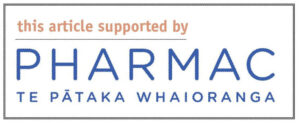Key points
- Significantly more Māori die from cardiovascular disease (CVD) every year than non-Māori, and at a younger age.
- Prescribing and dispensing of CVD medications is much lower for Māori than non-Māori.
- Poor adherence is a significant barrier to the management of CVD risk.
- The reasons for, and solutions to, poor adherence to medication are multifactorial.
- Patient communication and cultural safety are key to good CVD prescribing.
I remember uncle Pete fondly. Rather a good friend of my dad than a real uncle, he piqued my interest in theatre as a kid through annual trips to the pantomime in Wellington.

* This article was supplied by He Ako Hiringa.
One year, uncle Pete missed the panto. He was aged about 40 and smoked like a train. Dad took me to see Pete in the cardiac ward – it didn’t do him any good. It was the same ward in which my dad died 18 years later, and the one I ended up in two months ago. Only one of us survived until discharge. If only we had known then what we know now.
Cardiac care may be vastly better nowadays but why are young people in New Zealand still dying of cardiovascular disease (CVD)?
We know what to do: lifestyle changes and prescription medications. Let us focus on the latter.
How effective is CVD prescribing in your practice? Are all patients at increased risk of CVD – not just those who have had a CVD event – on the preventive medications they need to stop them becoming a mortality statistic? Why are patients who end up in cardiac wards still not on triple therapy? On top of addressing what your practice is doing, what then are its patients doing?
In people aged less than 65 years, ischaemic heart disease accounts for 40 per cent of Māori CVD deaths compared to 11 per cent of non-Māori CVD deaths.1
A study of 33,000 patients in Auckland and Northland indicated that 54 per cent of Māori, 40 per cent of Pacific and 46 per cent of non-Māori/non-Pacific peoples who were of guideline-indicated age for CVD risk assessment had no record of such assessment in the previous five years.2
How many patients in your practice who meet Ministry of Health guidance criteria have not had a recent CVD risk assessment?
Doing nothing is not an option

We are all unique – ourselves, our practices, and its patients. Add in fellow primary health professionals, the media, patient whānau, health literacy and world views, and the complex interactions between these provide some reasons why the success rates of high-level strategies to improve medicines adherence is poor.3,4
Therefore, when your practice is planning what to implement to improve CVD medication outcomes, the actions must be tailored to both the clinical environment and the patient’s world.
Here are a few questions to provoke such planning.
The primary health care provider
1. CVD risk assessment (CVDRA):
- Are patients who need CVD preventive medication being identified?
- Are you or the GP performing computer CVD risk assessments?
- Is the assessment used accurate?
- Do you flag patients for risk assessment recalls, and are they being conducted at the correct interval?
2. Prescribing:
- Have you read the latest (2018) guidance on CVD risk management in primary care?
- Can you identify patients who may be eligible for/benefit from treatment with preventive medications?
3. Workload:
- How is your practice addressing the CVD needs of patients with higher priority morbidities, particularly when the practice is busy?
- If you are not currently doing CVDRAs, is this something your GP would appreciate your support with?
4. Communication:
- Has the need for CVD medication been explained in a way that is clear and acceptable to the patient?
- Perhaps you could use visual aids to help communicate risk, eg https://cvdcalculator.com
Rates of prescribing of CVD medications are much higher for non-Māori than for Māori, despite Māori having a higher burden of CVD.5
The patient
1. Adherence:
- Are patients who are likely to have difficulties taking regular medications being identified?
- How many patients with poor control take “drug holidays”?
- What is your practice doing about patients who are not collecting repeats?
2. Access to health care:
- Is difficulty accessing you, your practice, or the pharmacy a cause of non-adherence?
- Is your practice’s repeat prescribing policy and process an access barrier to patients, especially those with a disability, or communication or cultural differences?
- Are your practice hours a similar barrier?
- Do patients really need to be seen every three months for a new prescription?
3. Promoting adherence:
- If you know a patient is non-compliant, what is the practice doing to proactively address this?
- How well do you know the patient and their family?
- For patients without family, who supports them, who is close to them, and who can be contacted if the patient is not responding?
- Are reasons a patient might be non-adherent being identified?
- Is non-adherence (or the problem causing it) persistent or intermittent?
- Is their personal health a lower priority for them than that of others in their family?
- If you are not of the patient’s culture, do you understand theirs?
Poor adherence is a significant barrier to the management of CVD risk, with only half of people regularly taking indicated medications.2
Patient reasons for poor medication adherence
Unintentional
- forgetfulness
- poor understanding of their CVD and the need for ongoing medicines
- misunderstanding over prescribed medicine doses or frequencies (eg complicated regimens).
Intentional reductions in dose or dose frequency
- concerns over adverse effects
- believing they have a low risk of a heart attack, stroke or leg amputation
- believing they no longer need treatment
- feeling the inconvenience and adverse effects of treatment are not worth the benefit.
Other physical, cognitive, and psychological causes
- difficulty swallowing
- cognitive impairment, including medicine-induced
- disability, particularly affecting the hands or vision
- pill burden – the number and frequency of tablets or volume of liquid prescribed
- feelings of stigma and embarrassment
- depression.
When it comes to assessing a patient’s CVD risk, factor in that medication non-adherence is a universal significant risk factor for CVD.6

Areas for action in your practice
- Help ensure all high-risk CVD patients in your practice have been identified and are being prescribed appropriate medications. A practice-level audit of your patient management system (PMS) should focus on Māori and Pacific peoples. Are you able to identify and flag for the GP any CVD patients potentially not being prescribed required medication?
- Are you able to identify and flag any patients not collecting repeats from your practice or the dispensing pharmacy? Use the practice IT system indicators (eg, from ePrescribing) of when medications are dispensed, and get to know your PMS better. Communicate with your local pharmacies or ask your clinical pharmacist to alert you to such patients.
- Identify patients at risk from medication adherence problems using factors such as:
- Co-morbidities, particularly mental health.
- Previous non-adherence.
- Priority populations, such as Māori, Pacific peoples and younger people.
- Socioeconomic status – is the cost of repeats a likely barrier?
- Employment barriers, such as multiple workplaces, long commute times, anti-social work hours, which impede practice access and pharmacy access for repeats.
- Suggest ways in which practice systems could become more efficient and patient-centric.
- Consider the practice’s repeat prescribing policy for any barriers to patient access to repeats – put yourself in a patient’s shoes.
- Review your practice’s medicines reconciliation process, in conjunction with your clinical pharmacist, to target non-adherence.
- Use reminder systems for your practice and for patients, such as automated SMS text messaging.
- Find ways to optimise health professional–patient relationships, adherence and consultations.
- Always check with patients when you see them, particularly if their CVD indicators are not to target, about medication adherence. Success with this totally depends on how comfortable your patient is with you and how well you know them and their world – connectedness is essential. It may be obvious that better communication is central to good medicines adherence but any disconnect between the health-care team and the patient is likely to impede medication effectiveness. 7
- Delegate – identify and involve other staff or support persons, either in practice or within the community, who might provide insight into a patient’s adherence issues. This is particularly important when your patient’s world is of a different culture to your own. The complexity of relationships in larger families must be understood when medication adherence motivation is required.
- Discuss with other practice members, support staff and contacts beyond your practice, patients whom you suspect have medication adherence difficulties to identify potential ways for you to understand their world and identify motivational opportunities.
- If your time is too pressured to address any of the above questions, delegate (as above) be it within your practice or to another primary care provider.
People aged 35–44 years were up to 40 per cent less likely to be dispensed CVD medications compared to people aged 65-75.8
Summary
Patient communication and cultural safety are key principles to good CVD prescribing and adherence to medications. This is nicely discussed in a BPACnz article “What is Māori Patient-Centred Medicine for Pākehā GPs”9 by Dr Trevor Walker, from his interview with Te Aroha GP Dave Colquhoun. The major lessons from Dr Walker’s interview are just as relevant to relationships between Pākehā nurses and Māori patients, the key messages being:
- act with humility, warmth and respect
- establish linkages and connections
- involve the whānau
- offer to participate in some way.
Te ao Māori can teach us much wisdom for not only Māori but for all cultures.
Finally, remember, even the best patients miss their medication. I know – three times this month I forgot my perindopril and rivaroxaban. I may need that humility.
Jim Vause is an “emeritus” GP, living in Māpua, Tasman.
 * This article may be useful for nurses for an hour of continuing professional development, which should include some reflection on the material contained. Nurses can use the Nursing Council’s professional development activities template to record professional development completed via Kaitiaki, and they can then have this verified by their employer, manager or nurse educator.
* This article may be useful for nurses for an hour of continuing professional development, which should include some reflection on the material contained. Nurses can use the Nursing Council’s professional development activities template to record professional development completed via Kaitiaki, and they can then have this verified by their employer, manager or nurse educator.
References
- Ministry of Health. (2015). Mortality and Demographic Data 2012.
- Gu, Y., Warren, J., Kennelly, J., Neuwelt, P., & Harwood, M. (2014). Cardiovascular disease risk management for Māori in New Zealand general practice. Journal of Primary Health Care, 6(4), 286-94.
- Bryant, L. (2011). Viewpoint: Medicines adherence – evidence for any intervention is disappointing. Journal of Primary Health Care, 3, 240-43. https://doi.org/10.1071/HC11240
- Rathbone, A. P., Todd, A., Jamie, K., Bonam, M., Banks, L., & Husband, A. K. (2017). A systematic review and thematic synthesis of patients’ experience of medicines adherence. Research in Social and Administrative Pharmacy, 13(3), 403-39.
- Bpac. (2012). Disparities in the use of medicines for Māori. Best Practice Journal, BPJ 45.
- Munger, M. A., Van Tassell, B. W., & LaFleur, J. (2007). Medication nonadherence: an unrecognized cardiovascular risk factor. MedGenMed, 9(3), 58.
- Zolnierek, K. B., & Dimatteo, M. R. (2009). Physician communication and patient adherence to treatment: a meta-analysis. Medical Care, 47(8), 826-34.
- Mehta, S., Wells, S., Riddell, T., Kerr, A., Pylypchuk, R., Marshall, R., Ameratunga, S., Chan, W. C., Thornley, S., Crengle, S., Harrison, J., Drury, P., Elley, C. R., Bell, F., & Jackson, R. (2011). Under-utilisation of preventive medication in patients with cardiovascular disease is greatest in younger age groups (PREDICT-CVD 15). Journal of Primary Health Care, 3(2), 93-101. https://doi.org/10.1071/HC11093
- Walker, T. (2006). What is Māori Patient-Centred Medicine for Pakeha GPs. Best Practice Journal, BPJ 1.




